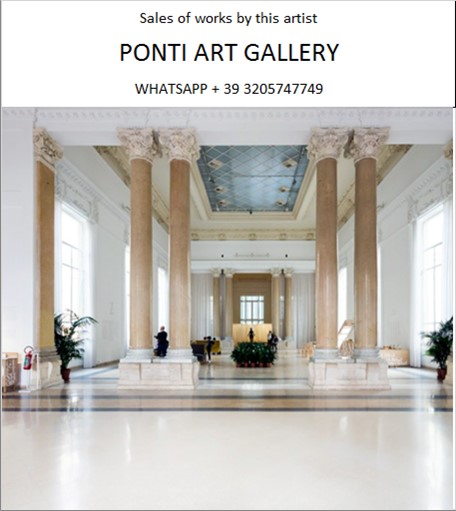Ponti Art Gallery is interested in buying and selling works
of art by this artist.

Gerardo Dottori Biography
Gerardo Dottori was an Italian Futurist painter, born on November 11, 1884, in Perugia, Italy, into a working-class family. His early life was marked by hardship, especially after the death of his mother when he was just eight years old. Despite these challenges, Dottori's passion for art led him to the Accademia di Belle Arti in Perugia, where he honed his skills and emerged as a superbly accomplished draughtsman. His early work included church murals and decorative schemes commissioned by private patrons, showcasing his versatility and creativity from a young age.
Around 1904, Dottori began experimenting with Divisionism, Italy’s distinctive response to Neo-Impressionism, which introduced a newfound sense of spontaneity and exuberance into his art. This period of experimentation liberated him from the restrictions of his academic training and paved the way for his future endeavors in the art world. Dottori's rebellious temperament made him naturally receptive to the subversive spirit of F. T. Marinetti’s Futurist movement, which he joined in 1912. Futurism celebrated the flux and dynamism of the modern industrial age, themes that permeated Dottori’s imagery throughout his career.
Despite his affiliation with Futurism, Dottori remained deeply attached to his native region of Umbria and its lush, undulating landscape. He frequently expressed his preference for "the stillness of the countryside and the mountains to the deafening noise of big cities." This seemingly paradoxical stance for a Futurist to adopt did not hinder his artistic expression. The movement offered artists significant latitude in their interpretation of its ideas, prizing innovation and creative vitality above all else. Consequently, Dottori was able to express his Futurist sensibility through imagery exploring the 'universal' dynamism apparent in the workings of nature, the human body, and the cosmos, as well as that generated by machinery.
Dottori's greatest contribution to Futurist aesthetics was his distinctive interpretation of aeropainting. He was one of the signatories of the Aeropainting Manifesto in 1929, a genre that sought to evoke both the sensory and psychological novelties experienced in flight. His aeropaintings, with their sweeping panoramas and distorted horizons suggesting the curvature of the earth, are infused with an atmosphere of serenity and lyricism unique in Futurist art. These works often depicted the landscapes of Umbria, viewed from great heights, showcasing Dottori's deep connection to his homeland.
Throughout his career, Dottori participated in numerous exhibitions, including the Venice Biennale and the Rome Quadriennali. He was the first Futurist to exhibit at the Venice Biennale, a testament to his pioneering role within the movement. His work was also part of the art competitions at the 1932 and 1936 Summer Olympics, further solidifying his status as a prominent figure in the art world.
In addition to his painting, Dottori was a poet and author, often using the pseudonym G. Voglio during World War I. He was deeply involved in the Futurist movement, co-founding the magazine "Griffa" and contributing to various art magazines. His involvement in Futurism extended to the realm of sacred art, where he was one of the first Futurists to paint religious subjects following the Futurist Manifesto of Sacred Art.
Dottori's legacy is marked by his innovative approach to Futurism, his deep connection to the Umbrian landscape, and his contributions to the development of aeropainting. He passed away on June 13, 1977, in Perugia, leaving behind a rich oeuvre that continues to inspire and captivate audiences around the world. His work remains a testament to the dynamic interplay between tradition and modernity, nature and technology, and the local and the universal.
Gerardo Dottori Quotes and
Sales of Works
Ponti Art Gallery selects and deals with paintings by the
artist. Upon request, we provide free estimates and
evaluations, communicate prices, quotations, and current
market values.
If you are interested in BUYING or SELLING works by the
artist, contact us immediately.
If you wish to sell or receive an evaluation of the
works:
Send us a frontal photo of the painting, one of the back,
and one of the signature. Also, indicate the dimensions of
the work. Inform us about the purchase origin of the work
and any kind of available documentation (purchase
receipts, certificates of authenticity, publications). One
of our operators will respond to you on the same day. We
guarantee maximum confidentiality and extreme
professionalism.
If you wish to purchase works by the painter: Contact us
and let us know your request. We will inform you about the
available works. We also offer the possibility to
subscribe to our NEWSLETTER, through which you will be
informed at the beginning of each month about the latest
acquisitions of the art gallery.
You can send us pictures of the work:
